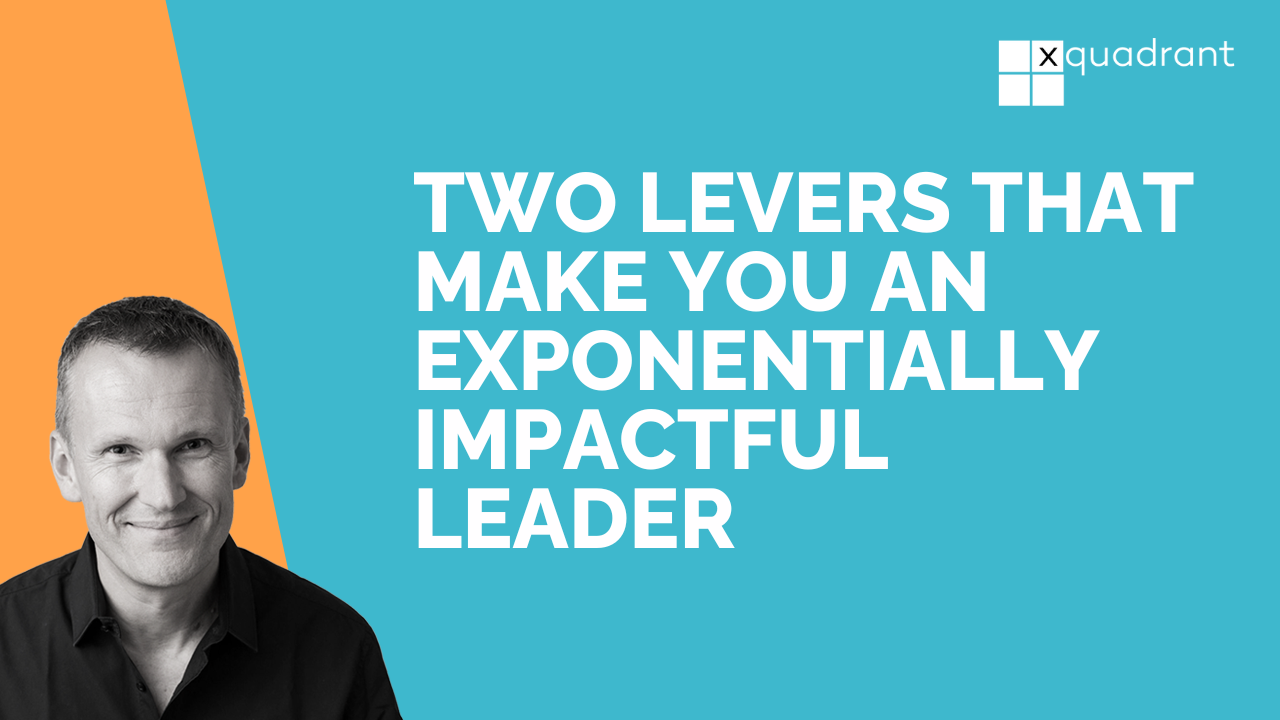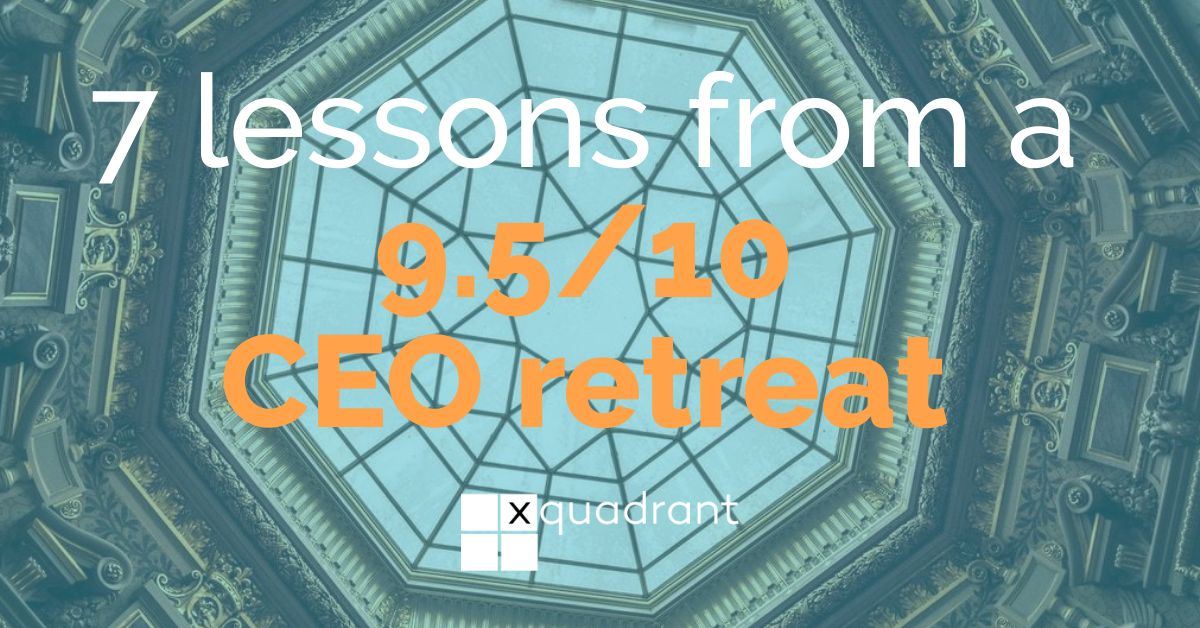Exponential leadership is my obsession.
In fact, I’m on a mission to help the world’s top leaders create and seize breakthrough opportunities that transform themselves, their businesses and, ultimately, change the world.
This shift from incremental to exponential is why I wrote Making TIME For Strategy. And it’s why I was delighted to receive an advance copy of “10X is Easier Than 2X: How World-Class Entrepreneurs Achieve More by Doing Less” by Dan Sullivan & Benjamin Hardy”. After all, the title is bang in the centre of my professional focus!
So, here’s what I intend to be an ultimate guide to the book, a detailed review along with my insights, actions, and takeaways.
Let’s get stuck in.
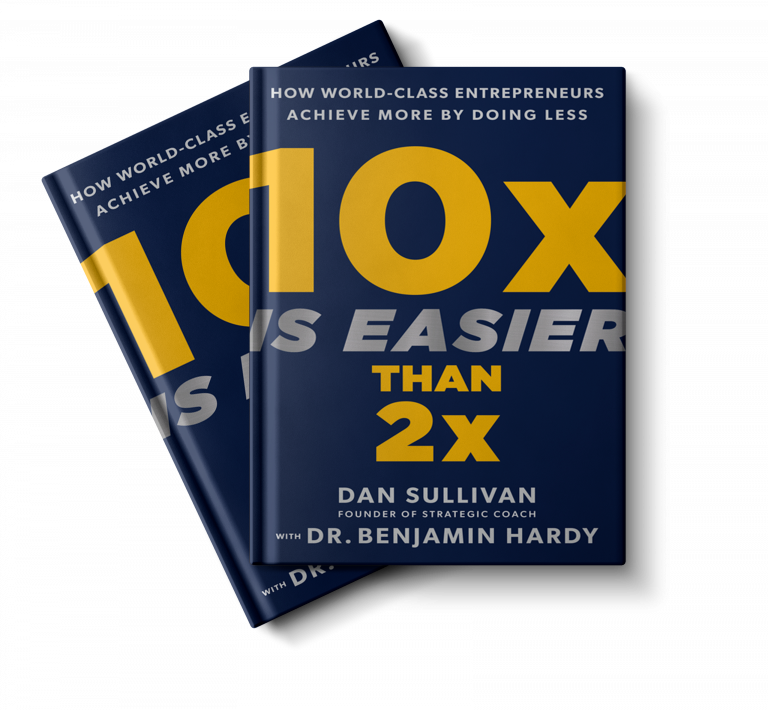
I. Introduction to “10X is Easier Than 2X” by Dan Sullivan & Benjamin Hardy
“10X is Easier Than 2X” is the third collaboration between Dan Sullivan (of Strategic Coach) & author Dr. Benjamin Hardy.
The goal of the book is to encourage entrepreneurial leaders to aim for breakthrough goals.
The comparison is set up between incremental goals (described in the book as “2X” growth) and breakthrough goals (described in the book as “10X” growth).
The book is squarely aimed at entrepreneurs, as mid-level managers will find they don’t have the necessary freedom to implement the recommendations. The book covers the following key themes:
The book is released in May 2023 by Hay House Publishing.
II. “10X is Easier Than 2X”: overview of the book
In this section, I’ll walk you through a high-level summary of each chapter of “10X is Easier Than 2X”, and explain the main arguments that Dan Sullivan and Benjamin Hardy offer.
Chapter 1: The surprising simplicity of 10x growth
With incremental growth everything seems important it's hard to identify things to stop doing. However, 10X goals - impossible goals - force you outside your current level of knowledge and assumptions forcing you to step back.
In doing so, you find that whilst there are many paths to get to incremental results, there are actually very few paths to get to 10X results. Therefore, gaining this clarity around the activities and people in your life that are producing most of your results is critical.
The corollary of this is that 10X growth requires eliminating the 80% of existing clients, roles, behaviours and mindsets that are holding you back. This is what makes it so transformative, and why 10X can be easier and simpler and require less effort than 2X.
The challenge is to have the courage to let go of the 80% of things that seem so important. It doesn't mean that you drop them entirely from your business but it does mean that other people need to take them on.
CHAPTER SUMMARY
Chapter 2: 10X the quality of everything you do
Focusing on mastery – doing a few things extraordinarily well – will be far more effective than doing many things at a commonplace level.
Jimmy Donaldson, also known as Mr. Beast, demonstrates this thinking nicely. He explains that by making YouTube videos that are just 10% better than everybody else, you may get four times the number of views. In other words, an increase in quality produces exponential results.
The assertion here is that 10X goals are easier than 2X goals because they are less competitive and require you to go deep on a few things rather than broad on many things.
Putting it another way, 10X doesn't require you to be 10X better than everyone else, but it does commit you to the path of mastery. It's therefore more about identity than an aggressive action plan.
CHAPTER SUMMARY
Chapter 3: 10X embraces abundance and rejects scarcity
This chapter opens with an interesting discussion around “needing versus wanting.”
Needing is a scarcity mindset based on our sense that we have to justify to other people why we want what we want. We assume that if we want something, then somebody else will not have it. Instead, if we take a wanting approach to life, we can set ourselves 10X goals.
The reality is we never need 10X goals, but we might well want them, and we need to step into that ownership.
The chapter then continues to explore the idea of mastery, linking it to the idea of a Unique Ability. This is the way in which we provide the most value for other people, and that nobody else could ever replicate even if they wanted to.
Our unique ability probably shows up in many areas throughout our entire life. So, it's important not to limit it to a very specific modality such as teaching, writing, consulting, leading.
When you have that confidence in your mastery, then you are liberated from having to continually be a “seller” of yourself. Instead, you can adopt a “buyer” mindset and only pursue opportunities and collaborations that fit with your 10X goals.
Once you get out of a scarcity mindset, you can set clear standards and boundaries. For example, what is the minimum value you are prepared to accept for your services? What kinds of opportunities will you accept, and what will you reject?
CHAPTER SUMMARY
Chapter 4: Uncover your 10X past to clarify your 10X future
Many high achievers are prone to being consistently frustrated and unsuccessful, regardless how much they've achieved. This is because they're measuring themselves towards all the goals they've set themselves. However, these goals or ideals and no matter how far we move towards them, the further they recede because we simply up-level what we are working towards.
Instead, measure your progress against where you have been before. Don't measure yourself against other people or any ideals. But look at how you have progressed. This creates a game you can win. Any situation can be harnessed for your learning.
This is the importance of reviewing progress against various timeframes. The progress in the last day, the last week, the last year and so on.
This chapter goes further and actually encourages you to list out your previous 10X leaps. Again, it’s important to remember that 10X is qualitative, not quantitative – so 10X leaps for Benjamin Hardy include being accepted for a PhD, getting married and starting a family, becoming a paid author, etc.
In this chapter, Benjamin Hardy and Dan Sullivan also introduce the idea of a “fitness function” and asks:
CHAPTER SUMMARY
Chapter 5: Take 150+ free days per year
This chapter summarises Dan Sullivan's well known time-blocking system:
The counterintuitive truth is that the more free days you take, the more successful you are likely to be. Innovation and mastery require you to be rested, creative and exploring ideas outside your domain. And letting go of the low value 80% activity requires you to give your team the “gift of not being there”, allowing them to get on and own the work themselves.
CHAPTER SUMMARY
Chapter 6: Build a self-managing company
This chapter is built around describing the transitions between four levels of entrepreneurship that every business owner will need to pass through on their journey to 10X goals:
CHAPTER SUMMARY
III. Key takeaways and actionable insights from “10X is Easier Than 2X”
There’s a lot in the book, and Dan Sullivan and Benjamin Hardy offer a entire list of takeaways at the end of each chapter – almost too many, I would argue! Here are, for me, the essential action points from the book:
Remember that 10X is qualitative, and means “playing at a whole new level” in some way. This is why I prefer to talk about “incremental vs exponential” or “breakthrough goals” to capture the same idea.
Take some time to get clear on what an inspiring 10X goal would look like, without feeling to justify why you need it. You can just want it.
Write down a draft version of your Unique Ability. Make sure it applies not just to your current work situation, but to your consistent zone of fascination, motivation and value-creation throughout the years.
The bottleneck is YOU, so find people to take on every task that is not related to your Unique Ability. Those are the tasks keeping you stuck on the hamster wheel.
Get specific about what what you are optimising for and what pursing mastery will look like. How will you use your Unique Ability to innovate and raise the bar on quality?
When you feel discouraged, immediately check that you aren’t measuring yourself against your 10X goals, and instead remember – and celebrate – how far you have already come.
Take extensive time away from work, and don’t sneak work into free days. As every athlete knows, recovery is an essential part of high performance. Schedule your free days a year in advance, so they’re locked in, and you can plan around them.
Speak with your team about what their Unique Ability is, and give them permission to find ways to spend more time in that are.
IV. “10X is Easier Than 2X”: strengths and limitations of the book
Inspiring call to action
Regular readers will know my entire mission in life revolves around helping the world’s top leaders seize breakthrough opportunities that transform their business and change the world.
So, this book – which is, at its heart, an inspiring call to pursue breakthrough goals – clearly resonates with me. It does prompt you to think bigger about what might be possible.
The biggest personal insights were:
Overall, the book does a good job, especially in the early chapters, of prompting reflection around what 10X might look like for you, and what might be holding you back.
Some great stories
Benjamin Hardy has tried hard to put some flesh on the conceptual bones provided by Dan Sullivan. Here’s one example I particularly liked:
Towards the end of the book, he gives a good example of some Christian missionaries he spoke with, where he identified that 20% of their effort resulted in 80% of their baptisms. Hardy pointed out that if they wanted to double their baptisms (their stated goal), they’d have to give up teaching 50% of the people with whom they were connecting.
Suddenly, the emotion cost of the breakthrough goal became apparent – were they ready to let go of all these relationships to pursue their true goal?
Missing examples
However, it’s definitely more a ‘why’ book than a ‘how’ book.
Much of the book is slightly frustrating because there are some good high-level stories and many interesting concepts, but little in the way of concrete examples to show how you might apply the concepts. For example:
I suspect the lack of examples and practical steps is because a key purpose of the book is clearly to generate leads for Dan Sullivan’s Strategic Coach training course. However, having actually participated in that programme, I observed the same under-representation of concrete examples there too. And, from someone as obsessed with concepts as me, this is saying something!
V. Recommended resources
If you’re looking to be convinced that 10X goals are worth giving serious consideration, and want to examine your mindset around this, I would definitely recommend this book. However, the book itself is just a starting point, and I’d recommend the following additional resources for anyone wanting to pursue a 10X journey.
Making TIME For Strategy (book/course)
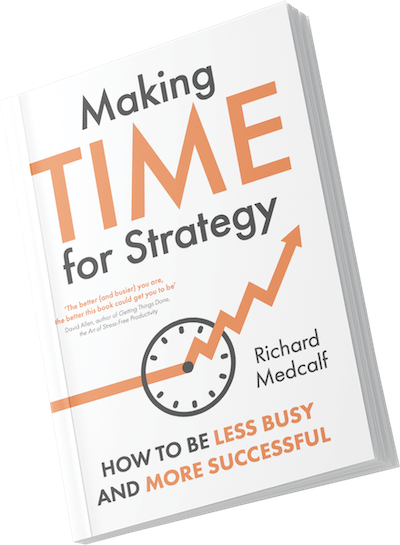
A core message of the “10X is Easier Than 2X” is the need to radically free yourself up for high-value activity. I wholeheartedly agree with this! However, doing this requires more than a simple exhortation! Let’s face it, if it was easy you’d already have done it. There are practical considerations, mindset blocks, and leadership factors to address.
For a practical guide that addresses the inner AND outer game, I would recommend checking Making TIME For Strategy. Yes, it’s a shameless plug for my book, but it’s so focused on “getting out of the incremental and into the exponential” that it would be irresponsible of me not to mention it. I’ll let the reviews speak for themselves. Take a look at the book here. Alternatively, take the online course to implement the key ideas, fast.
Who Not How (book)
As well as the current book, Dan Sullivan and Benjamin Hardy have collaborated on other projects including “Who Not How”, which goes into the mindset around delegation in much more detail. I think this is a great complement to “10X is Easier Than 2X”.
Work The System (book)
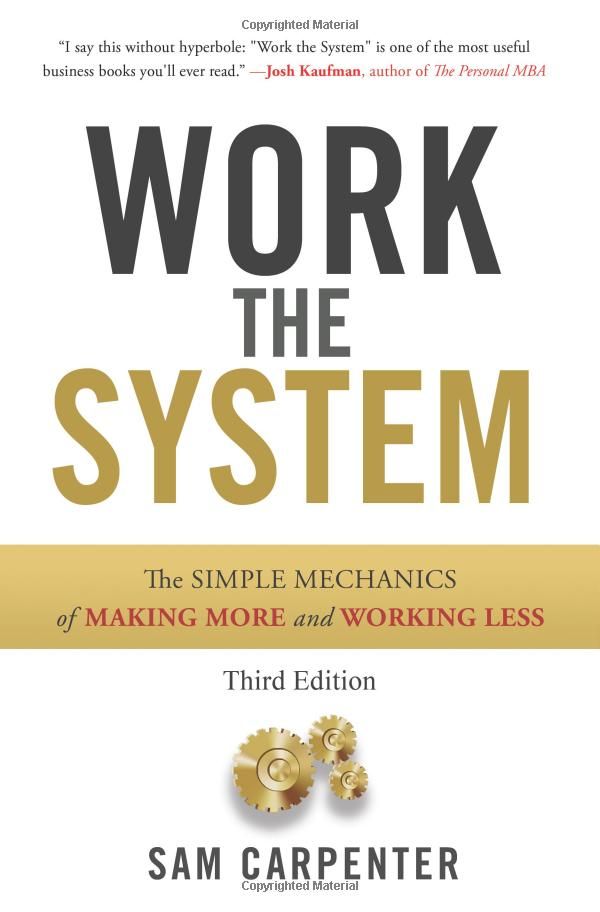
For a detailed look at how to actually extract yourself from business processes, I’d recommend “Work The System” by Sam Carpenter. It gives some great mindset shifts, but then dives into how this might actually be achieved.
Rivendell (mastermind/CEO community)
Of course, Xquadrant’s mission is to help top entrepreneurs and business leaders create breakthrough (10X) impact, through 1:1 coaching and our high-end CEO community, Rivendell.
We designed Rivendell to provide the personalised attention, intimate peer group, and strategic stretch to help mission-driven leaders transform themselves, their business and their world.
If you’re curious, discover our CEO Community, Rivendell, here.
VI. Should you read “10X is Easier Than 2X”?
So, does “10X is Easier Than 2X” deliver on its promise “How World-Class Entrepreneurs Achieve More by Doing Less”?
Well, partially.
It definitely offers an inspiring rallying cry to 10X growth.
It also, forcefully, makes the point that 10X growth will come from doubling down on your unique ability. This will require eliminating or outsourcing the 80% of activity that is keeping you stuck in the incremental.
For “rugged individualist” entrepreneurs especially, that will be a sharp wake-up call.
The book also offers a quick tour of some useful concepts and tools for the journey, although probably not in enough detail to be completely actionable.
However, to get you started on the 10X journey, it’s undoubtedly a recommended read.

